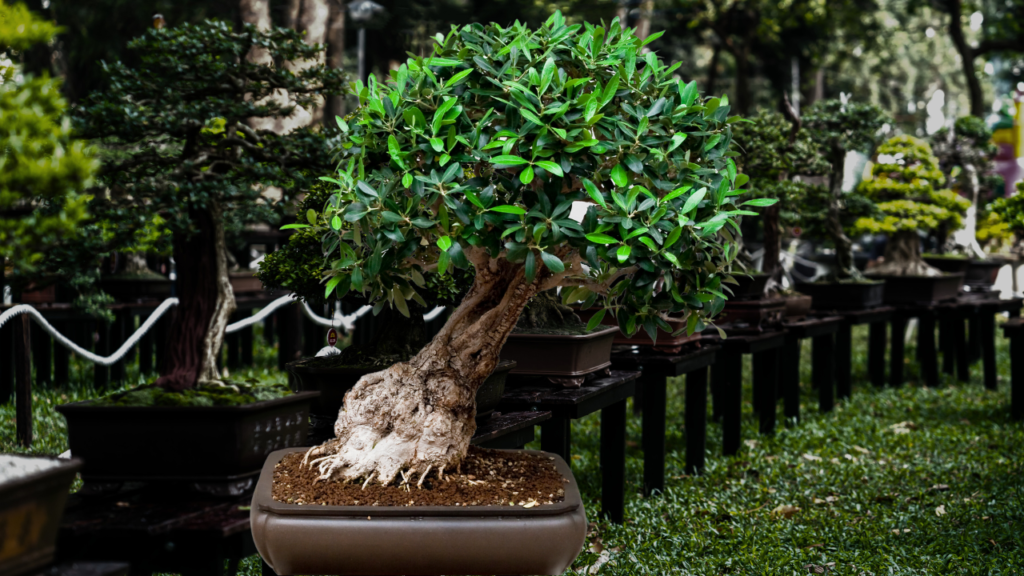The Olive tree, native to the Mediterranean region, is a symbol of peace, wisdom, and resilience. With its silvery-green foliage and gnarled trunk, the Olive tree is a popular choice for bonsai cultivation. Here’s a comprehensive care guide tailored for Olive bonsai:
| Olive Bonsai Quick Reference | |
|---|---|
| Attribute | Information |
| 🍀Common Names | Olive, European Olive |
| 🌿Botanical Name | Olea europaea |
| 🍃Family | Oleaceae |
| 🌾Plant Type | Evergreen tree |
| 📏Mature Size | Up to 50 ft. tall in natural habitat; typically much smaller when cultivated as bonsai |
| ☀️Sun Exposure | Full sun |
| ✂️Pruning | Prune in spring to early summer; however, light pruning can be done throughout the year to maintain shape |
| 🎭Common Bonsai Styles | Informal uprigh (Moyogi), Slanting (Shakan) |
| 🌼Bloom Time | Spring |
| 🎨Fruit Color | Green to black when mature |
| ❄️Hardiness Zones | 8-11 (USDA) |
| 🌎Native Area | Mediterranean region |
1. Positioning and Light:
- Sunlight: Olive trees thrive in full sunlight and require several hours of direct sunlight daily to maintain their health and vigor.
- Outdoor Living: Olives are best suited for outdoor living, benefiting from natural light, seasonal changes, and fresh air. They should be protected from extreme cold temperatures.
2. Watering:
- Frequency: Olive trees are drought-tolerant but prefer consistent moisture. Water when the top layer of soil begins to dry out, ensuring the soil never becomes waterlogged.
- Method: Water thoroughly, allowing excess water to drain from the pot. Ensure the pot has good drainage to prevent root rot.
3. Soil and Fertilizing:
- Soil: A well-draining soil mix, such as a blend of akadama, pumice, and some organic compost, is ideal.
- Fertilizing: Feed your Olive bonsai with a balanced, slow-release fertilizer during the growing season (spring to early autumn). Reduce feeding frequency during the dormant winter months.
4. Pruning and Shaping:
- Pruning: Olive trees respond well to regular pruning. Trim back new growth to shape the tree and remove any unwanted or weak branches.
- Wiring: Olive branches are relatively flexible, making them suitable for wiring. However, always monitor to ensure the wire doesn’t cut into the bark.
5. Repotting:
- Olive bonsai should be repotted every 2-4 years, depending on the tree’s age and the size of the pot. Early spring, just before the new growth starts, is the best time.
- When repotting, be gentle with the roots and remove only the outer layer of soil and roots.
6. Pests and Diseases:
- Olive trees can be susceptible to pests like aphids, scale insects, and the olive fruit fly. They can also face fungal diseases. Regular inspections and early interventions are key.
7. Winter Care:
- While Olive trees are relatively cold-hardy, they should be protected from frost and extreme cold, especially when young. Consider placing them in a sheltered spot or using frost protection covers during harsh winter months.
8. Recognizing Olive Bonsai Features:
- Olive trees are characterized by their silvery-green, elongated leaves and their distinctive, often rough bark. They also produce small white flowers, followed by the iconic olive fruits.
Bonsai Care Essentials
Conclusion:
Olive bonsai trees are a reflection of the Mediterranean’s rich history and culture. Their timeless beauty and symbolic significance make them a cherished choice in the bonsai world. With dedicated care and a deep appreciation for their unique characteristics, your Olive bonsai will stand as a testament to nature’s enduring spirit and the millennia-old bond between humans and olives.
